Even on "our" ("the german" the redaction) bank of the Odra river
the typical german summer weather once again at his best.
Cool, windy, cloudy, with a few
rain drops in between. Will you
take photos, the houses look dark before the gray heaven background, which could dazzle too.
The starting point is at the northern
end of the Odra valley, in Alt Cüstrinchen (
Stary Kostrzynek) on the
Neumark side. If the valley of the
Oder will just leave now, remain
simple at the end of the war restored
church and also the Odra-Valley-
half-timbered houses in the lowlands
back.
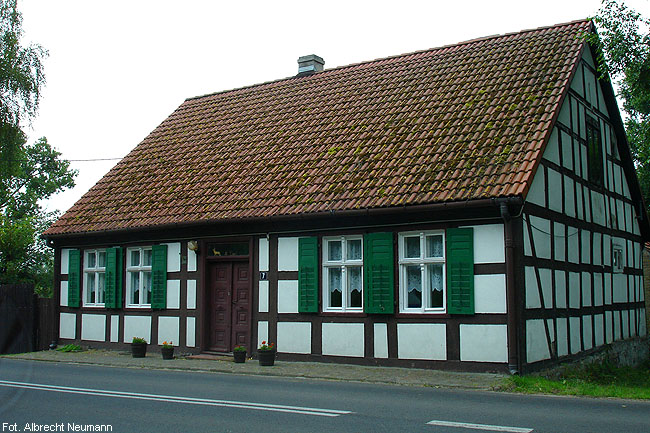
Alt Cüstrinchen (Stary Kostrzynek):
At the Neumark eastern edge
of the Odra Valley
Shortly before Zehden (php (
Cedynia ) remarkable for the north heights right of the road.
The Zehden Heath is a small nature reserve.
So steep rise and dry here the glacial sand mounds,
that today's rain quickly evaporate or seep
and steppe vegetation on the slopes, where the pines do not
could find support, to spread out more.
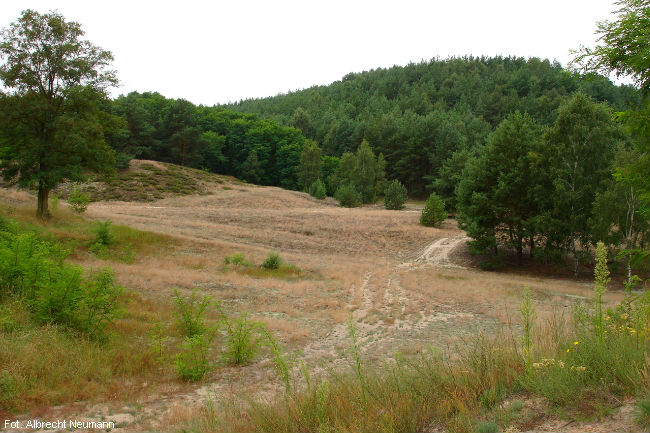
The Zehden Heath near Zehden (Cedynia)
Already in Zehden rises the ground
now finally, and soon reaches a
gently up and down of the Coast plateau, which
travelers often accompanied in the Neumark.
Included in the first stubble and plowed
sandy fields are small ponds with reed-bordered
water hole in it.
Between them runs the asphalt
road to the couple of villages Groß-
and Kleinmantel, which parts are connected together by an old cobblestone road
with summer way, among the slowly rustling crownes
of old lime trees.
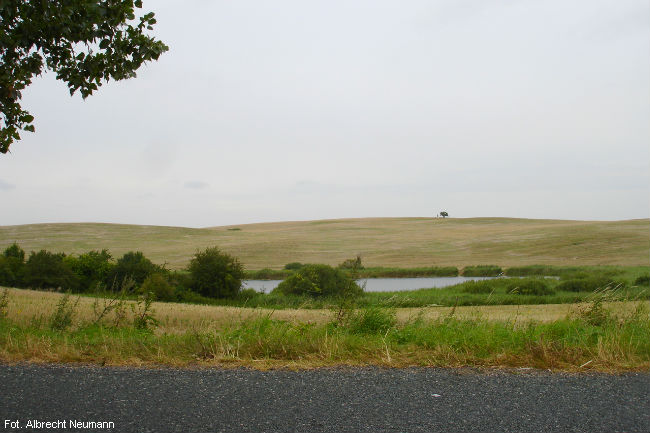
In the western Neumark near Wrechow
(Orzechów)
Far away you feel here from the
noisy, restless city.
The church of Groß Mantel made of granite blocks
comes from the early Gothic time;
Klein Mantel has an stone chapel, built in the late
Medieval.
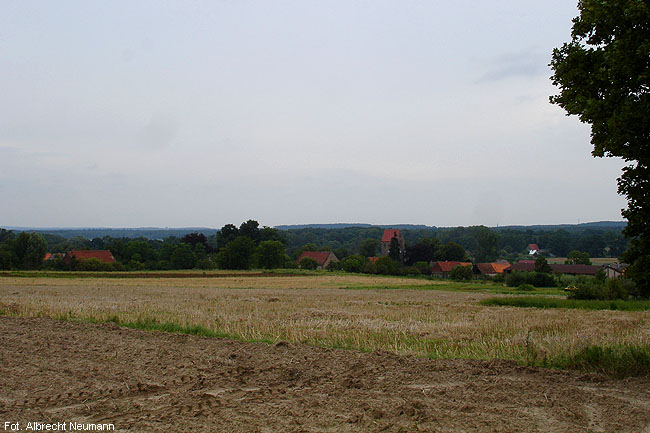
At the edge of an field near
Mantel (Mętno)
Now the road leads over a mountain top into Königsberg (
Chojna).
The name of Königsberg is
more common, so that the
local Königsberg had adding "in the
Neumark", to not being confused with the former
capital of East Prussia (now
Kaliningrad).
Königsberg / Nm. is for today
the last city, which shows, as almost everywhere
in the wider region left
or right of the Oder river, the follows of the bad fights in
the last weeks of the war.

Old cobbled street between Groß
and Klein Mantel (Mętno)
Like an wonder the other villages between Neudamm
Dębno, Arnswalde (Choszczno) und Pyritz (Pryzyce; Pommern) - but the last ones
itself not - was not destroyed. Too Königsberg was not destroyed in the war, but burned down after the capture by the Red Army.
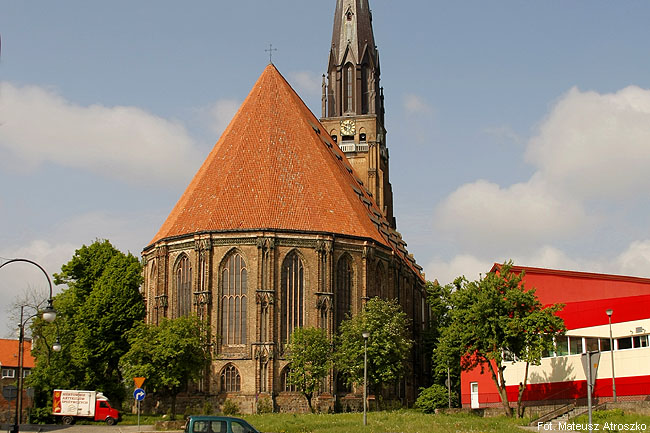
Königsberg/Nm. (Chojna):
Marienkirche made by Hinrich Brunsberg
In the east of the provincial town you can find
some remarkable mansions and public buildings, but in the
center you are escorted by stocky newly built houses or simply
emptyness, because the usual
markian half-timbered houses were victims of the flames.
Normally you cannot see from the market different city gates at the
same time.
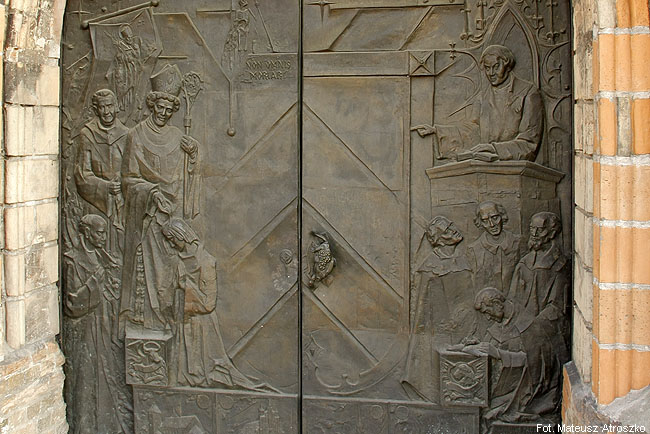
Königsberg (Chojna): "Deads door"
at the St. Marys church
At the entrance into the city threw the Schwedt gate I am passing
the ruine of the hospitals chapel. Such institutions was in the Medievel
ever outside of the town walls. The wall here, at the other side is
the Bernickow gate, is good conserved and equipped with wall houses.
In Königsberg the late Gothic
Brick Master Hinrich Bruns,
which, born in the country
at the Weichsel, worked between Posen
(Poznan), Baltic Sea and the Elbe, left two of his work testimonies.
This is in addition to Tangermünde the second example of a
town hall of Brunsberg. The gables seated with crabs, form stone friezes
and the delicate roses on the brick
gables, the delicate part pillars
bear his signature.
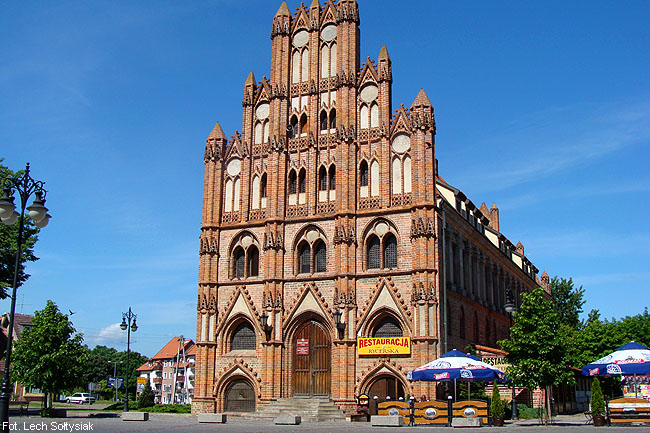
Königsberg/Nm. (Chojna): Gables
of the town hall
Adjacent is the towering
St. Mary's Church, the outer decoration,
quite Brunsberg-typical, the viewer
seems familiar, if that already has seen the
St. Catherine's Church in Brandenburg / Havel
or St. Mary's Church in the not too
far situated Stargard i. Pom. (Stargard
Szczecinski). Both works of art,
church and city Hall,reestablished after
1945 by Polish restorers and
also with German participation effort
offers high quality as
been. Just off, down the slope,
is still the charming complex of
Augustinian monastery at the wall, beyond
which the Wall Gardens of the moist and fertile floodplain of the river
Röhrike (Rurzyca) joined.
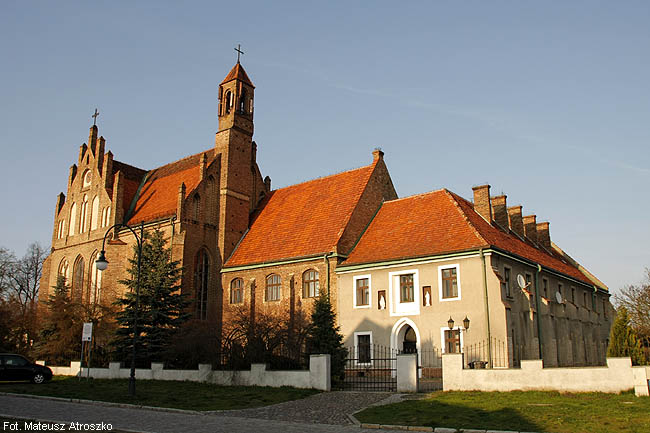
Königsberg/Nm. (Chojna):
View into the Klosterstraße
I have not leaved Konigsberg even
now is the amalgamated
Village Bernickow (Barnkowo)
achieved. Even the Church has a
East gable of brick, perhaps,
under the influence of the buildings in the
nearby city, through considerable hides
is divided.
The landscape, once the north-east of
Brandenburg, now goes along the old
provincial border into the pomeranian area.

Steinwehr (Kamienny Jaz):
Once Pomeranias deep south
An detour off the road
to the north leads us to pavements between
woods and fields, soon to Steinwehr
(Kamienny Jaz). Very silent
it is here, and nothing suggests
that the sleepy village used to be
was the most southern of the whole Pomerania.
Nearby is Rörchen (
Rurka), where
a granite Templar chapel is on the edge of the village.

Wildenbruch (Swobnica),
On the village road
In german times disfigured as a distillery,
now progressing the correction of the disfiguement of the little church.
The small street goes on to
Jädersdorf (Strzelczyn) Thänsdorf
(
Grzybno) and threw a lush deciduous forest
to Wildenbruch (
Swobnica). It
formerly belonged to the municipality Greifenhagen
(Gryfino); near Potsdam there is a
another Wildenbruch.
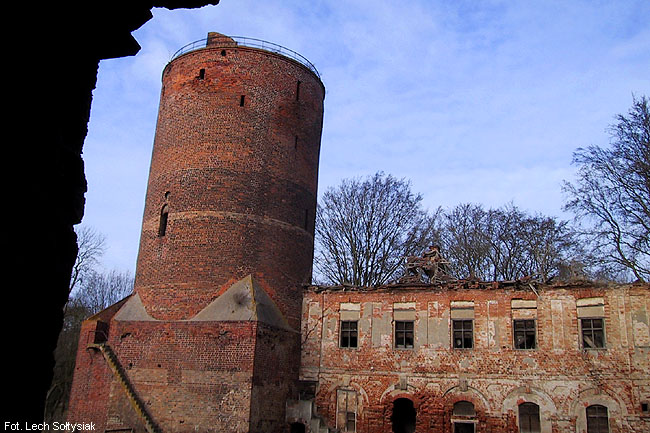
Wildenbruch (Swobnica):
The castle tower is to see
At a fork of the road is a
crooked sign made by an chipboard
"Do Zamku" with means "The castle". But you will
need a lot of local knowledge or persistence,
to go to the wild, overgrown
and crumbling walls. Between the tree-tops
peeps out the brick keep,
in the long past time part of the
castle of the Templars and then the
St. John knights. These two orders
left their marks in several places right of the Oder.
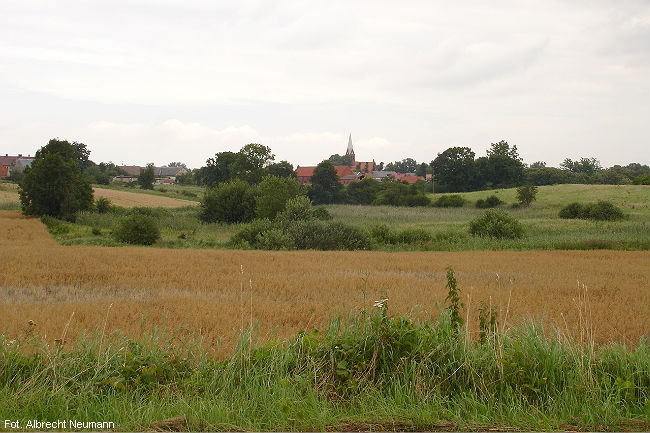
In the fields near Wildenbruch
(Swobnica)
Again and again the quiet street,
by Stresow (Strzeszów) and now
back to the old Brandenburg, from small
grain fields and enchanted by
bush-accompanied ponds.
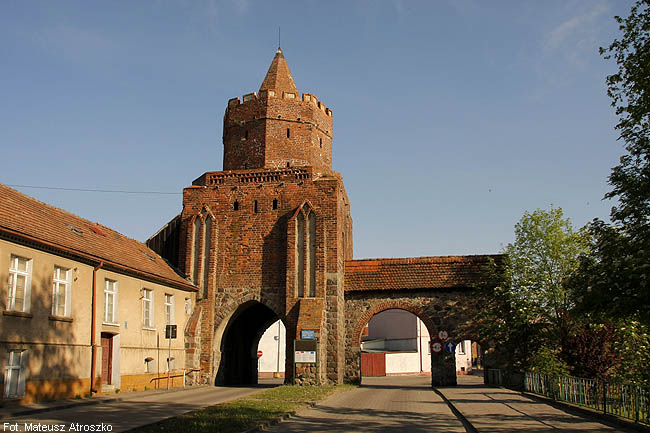
Bad Schönfließ (Trzcińsko-Zdrój):
At the Soldin gate
In this far away situated edge of two
provinces the small town of Bad
Schönfließ (
Trzcińsko Zdrój) dreams away. Conserved are the most original
markian streets, the city hall, the church as well and the
Soldin and Königsberg gate.
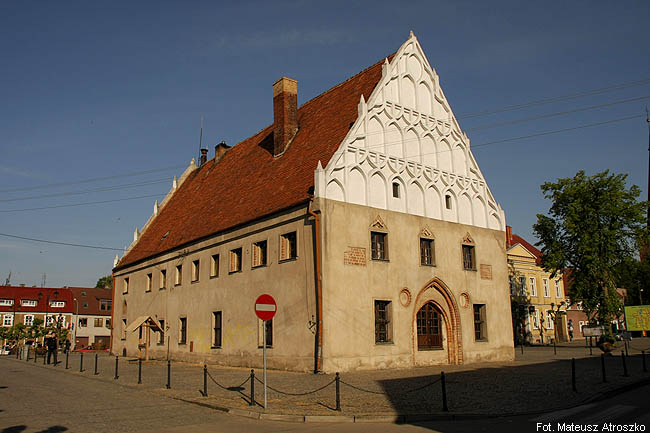
Bad Schönfließ (Trzcińsko-Zdrój):
Town hall at the market place
There is not much going on around here, but if you know how many nearby towns and villages were destroyed during the war, you appreciate every unharmed row of houses and every intact view of a place that lets us look into the past.
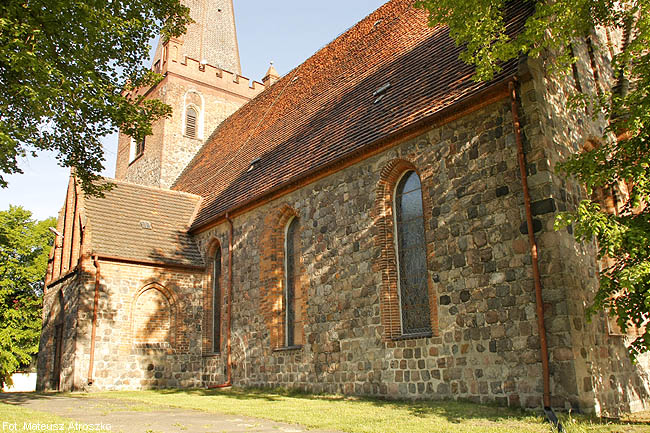
Bad Schönfließ (Trzcińsko-Zdrój):
city church
One piece is still to go threw the
unhurried, sometimes of a lake
enriched neumarkian landscape
, then the former municipality
town Soldin (
Myślibórz) is in front of me.
Even here, though of course with some strong
patina, the eye is spared of
wastelands, vacant lots, and traces of the loss. Three Gothic
Chapels, one of them almost more a shrine,
has Soldin.
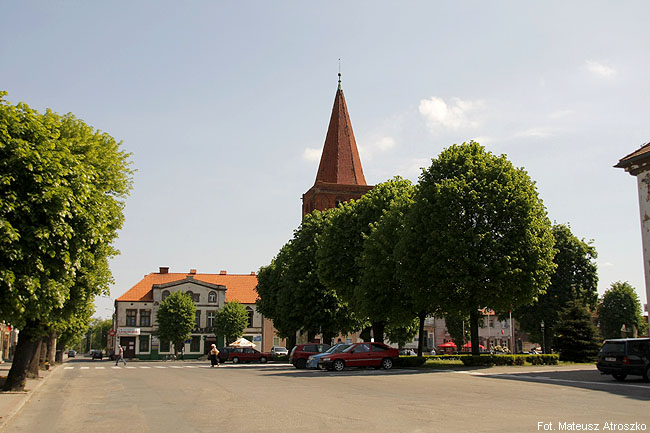
Bad Schönfließ (Trzcińsko-Zdrój):
In the old town
The church served in the Medieval as a residence of a bishop, so
sometimes was spoken from the church as the "dome".
At the market at the town hall still shows
now the clear language of the Rococo in Brandenburg, in addition, other
roughcast buildings or neo-Gothic authoritie buildings,
often with the original
white-painted window crosses.
Soldin was a markian town.
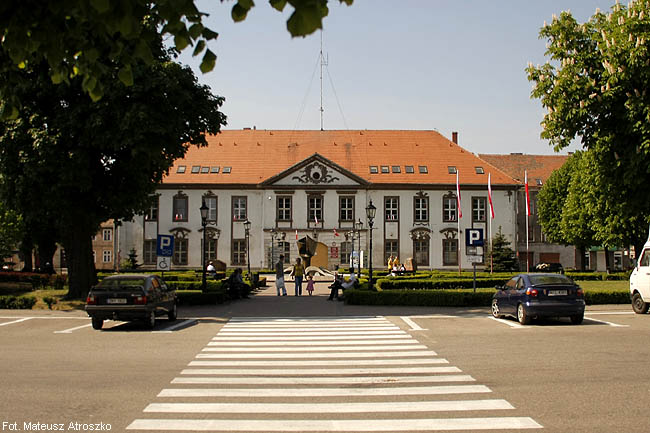
Soldin (Myślibórz):
Market place with town hall
Herr walls includes the Powder Tower,
the Neuenburg and Pyritz
gates. Neat is the small-scale
pavement on many roads.
You can count the cars, which you outside of the cities
met since you leaved the Oder, sometimes on an hands fingers. A short piece
it goes now to the busy
Highway 3, which links Lower Silesia
with the Baltic Sea, in
big steps to Pomerania and
Stettin (Szczecin).
The last goal on this trip
is already Lippehne (Lipiany), where you roll-in
after leaving the main road in the
landscape rich of meadows and water. Before the street bypass
shortened the way, the Soldin gate
still stands curiously in the northeast of
Lippehne, although opposed Soldin
found in the southwest, is.
As long as there was no shortcut, people on the way to Soldin had to take this eastern detour, where it was the easiest to cross the boggy valley.
While the
Soldin gate, normally in the area of the
Mark Brandenburg, building with common construction
aperture between a gable roof
is, stands at the other end, beyond
of church, a small market and town hall,
the Pyritz gate, with some
copies in Bad Schönfließ and Konigsberg in common
a different design:
Square floor plan, pinnacled
battlement, octagonal brick
helmet. Perhaps even corner towers.
Had those goals related
in southern Germany? Similar to me
already in Ingolstadt, Upper Bavaria, met.
Why not really - even
some strong influence from northern Italy
can be in the former and current northern Germany
brick area.
Think to the monastries Jerichow near Magdeburg or Kolbatz
(Kolbasz) near Stargard. How exotic must this be for the
peoples in the Medieval, for which of them may feels the route, we
made today was a longtime trip.
The Centuries with all its troubles are
on this quiet spot on
northern edge of the Neumark, already
almost in the Pomeranian, trudged along. It
has remained quiet here. And once
may be seen these summer days
have, where the cool wind
Clouds to the east with further
and takes in the Willows on the Water
rushes.